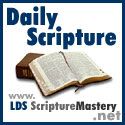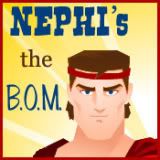I remember the very first time I saw the magnificent painting The Shepherds and the Angel
by Carl Heinrich Bloch. It really stirred my emotions---the beautiful
deep black starry night, the glorious angel emanating radiant holy
light, the startled but humble shepherds, the pen of ewes corralled for
protection next to the shepherds. It was stunning!
I
have spent hours over the years pondering this amazing painting, and
have concluded that the Spirit of the Lord made known to Carl Heinrich
Bloch some important truths surrounding that holy night.
If
you look closely at this beautiful scene, you will see that he depicts
the angel’s visit to the shepherds on a spring night … not the dead of
winter, which was commonly believed in Master Bloch’s time.
And
it is my opinion that it was also revealed to the artist (though there
is no evidence to substantiate my claim other than the powerful spirit
of this painting) that the angel’s glorious Annunciation … “For unto you
is born this day in the city of David a Saviour, which is Christ the
Lord” was not delivered to ordinary shepherds, nor were they ordinary
lambs that were being birthed that holy night (Luke 2:11).
Only the Holy
Anciently,
Jewish law proclaimed that only flocks designated for temple sacrifice
could be raised near cities; Bethlehem being in close proximity to
Jerusalem––the seat of Roman power and the Temple. Thus it was known to
all that the firstborn male lambs from the area around Bethlehem,*
commonly known as the City of David, were considered holy, and set aside
for sacrifice in Jerusalem. (Even to this day in some parts of the
Middle East this practice still exists.)
Generations
of hereditary shepherds tended these sacred flocks, designated by
Temple Priests from their youth and specifically trained for this royal
task. It was an honor and a sacred duty. They were protectors and
guardsmen of these special flocks and were willing to risk their lives
for their sheep.
They
were taught and spiritually educated in what a sacrificial lamb must be
like, and to make sure that these lambs were never injured, damaged or
blemished. Such a shepherd was King David in his youth… on the very same
hills.
In
the spring, during lambing season, the bawling of sheep rang across the
hillsides and fields of Bethlehem. The newborn lambs were brought to
the Tower of the Flock––a large stone tower in Shepherd’s Field
anciently referred to as Migdal Eder––where a ceremonially cleansing of
the new lambs took place in a specified birthing room.
These
shepherds, under special rabbinical care, would routinely place the
newborn lambs in a hewn out depression in a limestone rock known as “the
manger” and wrap them in swaddling bands (strips of gauze-like cloth)
to prevent them from thrashing about and harming themselves. Once they
had calmed down they could be inspected to see if they qualified for
temple sacrifice … “without spot or blemish” (see The Jewish Oral Tradition & Alfred Edersheim, The Life and Times of Jesus the Messiah).
“And
so it was, that, while they were there, the days were accomplished that
she should be delivered, And she brought forth her firstborn son, and
wrapped him in swaddling clothes, and laid him in a manger; because
there was no room for them in the inn” (Luke 2:6-7).
A Type and Shadow or the Last Resort?
There
are scholars of ancient scripture who believe that Joseph and Mary were
directed by heavenly angels to the Tower of the Flock––Midgal Eder––
for the birth of Jesus, the Lamb of God, the ultimate sacrifice!
Whether
Joseph and Mary ended up at Midgal Eder, having been led there by Holy
angels in symbolic testament of things to come, or whether they ended up
in an animal stable as a means of desperation or last resort, we will
not know until those details of Christ’s birth are revealed.
But
I do find myself filled with tremendous emotion and overwhelming
gratitude for my Savior, as I ponder His birth and the profound
symbolism behind it all.
* Beth Lechem in Hebrew means “House of Bread” and held no real significance until “He who would be known as the Bread of Life was born” (Ensign, December 2013, Come Let Us Adore Him).










No comments:
Post a Comment